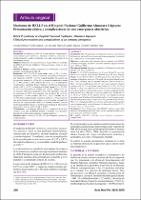Síndrome de HELLP en el Hospital Nacional Guillermo Almenara Irigoyen: Presentación clínica y complicaciones de una emergencia obstétrica
Related Resource(s)
https://amp.cmp.org.pe/index.php/AMP/article/view/1528Date
2009Author(s)
Vicetti Miguel, Claudia Pamela
Franco Escobar, David Lenin
Caballero Vera, Héctor Gerardo
Metadata
Show full item recordAlternate title
HELLP syndrome in Hospital Nacional Guillermo Almenara Irigoyen:
Clinical presentation and complications of an obstetric emergency
Abstract
Introdución: el síndrome de HELLP es una patología multisistémica
caracterizada por hemólisis, enzimas hepáticas elevadas y
trombocitopenia1, siendo considerada como una complicación de la
preeclampsia severa.
Objetivo: Determinar las características de las pacientes con Síndrome
de HELLP del Hospital Guillermo Almenara Irigoyen entre los años
2005 y 2008.
Material y método: Análisis retrospectivo de 45 historias clínicas de
pacientes con Síndrome de HELLP.
Resultados: El 71,1% (32/45) tenía edades entre los 20 y 35 años.
Preeclampsia severa y aborto fueron los antecedentes obstétricos
más frecuentes (33,33% y 26,7%, respectivamente). Se registró una
hemoglobina mínima de 4,12mg/dL, un recuento plaquetario mínimo
de 17 000 cel/mm3 y DHL máxima de 8 050 U/L. Las principales
complicaciones reportadas fueron: Síndrome de Distress Respiratorio
Agudo (14,0 y 31,11%) e Insuficiencia Renal Aguda (10,0 y 22,2%).
El 26,7% (12/45) estuvo en Unidad de Cuidados Críticos (UCC) y
se encontró diferencia significativa entre estas pacientes y las que
no estuvieron en UCC, con respecto a la presencia de recuento
plaquetario < 50 000 cel/mm3
. (66,7% vs. 24,2%, p=0,009). 68,9%
(31/45) fueron diagnosticadas durante la gestación y 30 pacientes de
este grupo tuvieron parto por cesárea. La complicación neonatal más
frecuente fue la prematuridad (80,6%). Se encontró diferencia entre las
medias hemoglobina materna y el antecedente neonatal de depresión al
nacer (8,15 ± 1,63 vs. 10,53 ± 2,44, p=0,007).
Conclusiones: Los hallazgos muestran que el síndrome de HELLP
conlleva a una alta morbilidad materna y neonatal, cuyo desenlace
depende de un diagnóstico temprano y manejo oportuno Introduction: HELLP syndrome is a multisystemic disease characterized
by hemolysis, elevated liver enzymes and trombocitopenia1, considered
as a complication of severe preeclampsia.
Objectives: o determine the characteristics of patients with HELLP
syndrome in Hospital Nacional Guillermo Almenara Irigoyen between
years 2005 and 2008.
Material and method: Retrospective analysis of 45 medical records from
patients with HELLP syndrome.
Results: 71.1% (32/45) of patients were between 20 and 35 years old.
Severe preeclampsia and previous abortion were the most frequent
findings in past obstetric history (33.33% and 26.7%, respectively). The
minimum hemoglobin value was 4.12 mg/dL, the minimum platelet count
was 17,000 cell/mm3, and the maximul value for LDH was 8,050 U/L.
Main maternal complications reported were acute respiratory distress
syndrome (14, 31.11%) and acute renal failure (10, 22.2%). 26.7% of
patients (12/45) were admitted to the Critical Care Unit and there was
a significant difference between the number of patients admitted and the
ones who were not, with respect to platelet counts below 50,000 (66.7%
vs. 24.2%, p=0.009). 68.9% patients (31/45) were diagnosed during
pregnancy, and 30 of them delivered their babies by a Cesarean section.
The most frequent neonatal complication was pre-term birth (80.6%).
There was a significant difference between mean maternal hemoglobin
concentrations and a neonatal history for depression at birth (8.15 ±
1.63 vs. 10.53 ± 2.44, p=0.007).
Conclusions: These findings show that HELLP syndrome causes high
maternal and neonatal morbidity rates, and the outcome depends on an
early diagnosis and timely therapy
Collections
- Artículos científicos [890]






